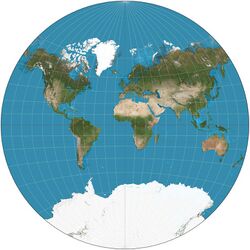Polyconic projection class


Polyconic can refer either to a class of map projections or to a specific projection known less ambiguously as the American polyconic projection. Polyconic as a class refers to those projections whose parallels are all non-concentric circular arcs, except for a straight equator, and the centers of these circles lie along a central axis. This description applies to projections in equatorial aspect.[1]
Polyconic projections
Some of the projections that fall into the polyconic class are:
- American polyconic projection—each parallel becomes a circular arc having true scale, the same scale as the central meridian
- Latitudinally equal-differential polyconic projection
- Rectangular polyconic projection
- Van der Grinten projection—projects entire earth into one circle; all meridians and parallels are arcs of circles.
- Nicolosi globular projection—typically used to project a hemisphere into a circle; all meridians and parallels are arcs of circles.[2]
A series of polyconic projections, each in a circle, was also presented by Hans Mauer in 1922,[3] who also presented an equal-area polyconic in 1935.[4]:248 Another series by Georgiy Aleksandrovich Ginzburg appeared starting in 1949.[4]:258–262
Most polyconic projections, when used to map the entire sphere, produce an "apple-shaped" map of the world. There are many "apple-shaped" projections, almost all of them obscure.[2]
See also
References
- ↑ An Album of Map Projections (US Geological Survey Professional Paper 1453), John P. Snyder & Philip M. Voxland, 1989, p. 4.
- ↑ 2.0 2.1 John J. G. Savard. "The Dietrich-Kitada Projection".
- ↑ https://pubs.usgs.gov/pp/1453/report.pdf [bare URL PDF]
- ↑ 4.0 4.1 John P. Snyder (1993). Flattening the Earth: Two Thousand Years of Map Projections. ISBN 0-226-76747-7.
External links
- Table of examples and properties of all common projections, from radicalcartography.net
 |

